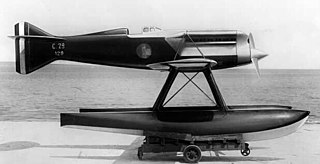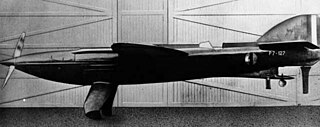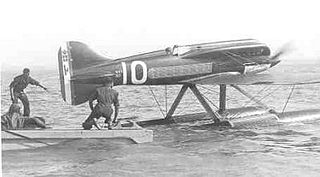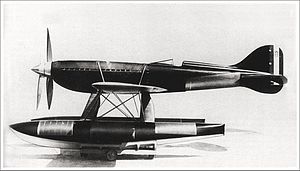
The Coupe d'Aviation Maritime Jacques Schneider, also known as the Schneider Trophy, Schneider Prize or (incorrectly) the Schneider Cup is a trophy that was awarded first annually, and later biennially, to the winner of a race for seaplanes and flying boats. In 1931 Britain met the conditions to retain the Trophy permanently; it is held at the Science Museum at South Kensington, London.

The Supermarine S.6B is a British racing seaplane developed by R.J. Mitchell for the Supermarine company to take part in the Schneider Trophy competition of 1931. The S.6B marked the culmination of Mitchell's quest to "perfect the design of the racing seaplane" and represented the cutting edge of aerodynamic technology for the era.

Mario Castoldi was an Italian aircraft engineer and designer.

Francesco Agello was an Italian test pilot.

The Macchi M.39 was a racing seaplane designed and built by the Italian aircraft company Aeronautica Macchi in 1925–26. An M.39 piloted by Major Mario de Bernardi (1893–1959) won the 1926 Schneider Trophy, and the type also set world speed records that year.

The Supermarine S.5 was a 1920s British single-engined single-seat racing seaplane built by Supermarine. Designed specifically for the Schneider Trophy competition, the S.5 was the progenitor of a line of racing aircraft that ultimately led to the Supermarine Spitfire fighter.

The Curtiss R3C is an American racing aircraft built in landplane and floatplane form. It was a single-seat biplane built by the Curtiss Aeroplane and Motor Company.

The Curtiss CR was a racing aircraft designed for the United States Navy in 1921 by Curtiss. It was a conventional single-seater biplane with a monocoque fuselage and staggered single-bay wings of equal span braced with N-struts. Two essentially similar landplane versions were built as the CR-1 and CR-2, which were both eventually converted to seaplanes as the CR-3 in 1923 and CR-4 in 1924. A refined version was developed for the US Army Air Service under the designation R-6. These latter two aircraft featured refined aerodynamics included surface-mounted radiators.

The Gloster VI was a racing seaplane developed as a contestant for the 1929 Schneider Trophy by the Gloster Aircraft Company.

The Macchi M.52 was an Italian racing seaplane designed and built by Macchi for the 1927 Schneider Trophy race. The M.52 and a later variant, the M.52bis or M.52R, both set world speed records for seaplanes.

The Navy-Wright NW series, also called the Mystery Racer were racing aircraft built by Wright Aeronautical Corporation at the request of the US Navy. Although innovative, both prototype racers were lost before achieving their true potential.

The Gloster IV was a British racing floatplane of the 1920s. A single-engined biplane, the Gloster IV was a development of the earlier Gloster III intended to compete in the 1927 Schneider Trophy race. One aircraft competed in the race, but retired part way through. The three aircraft built continued to be used as trainers by the High Speed Flight for several years.

The Fiat C.29 was an Italian racing seaplane designed by Celestino Rosatelli and built in the late-1920s by Fiat Aviazione especially for the 1929 Schneider Trophy air race. Unused in the race, of the three aircraft built, two were destroyed in flying accidents while the third is on display in a museum.

The Savoia-Marchetti S.65 was an Italian racing seaplane built for the 1929 Schneider Trophy race.

The Piaggio P.7, also known as the Piaggio-Pegna P.c.7, was an Italian racing seaplane designed and built by Piaggio for the 1929 Schneider Trophy race.

The Macchi M.33 was an Italian racing flying boat which competed in the 1925 Schneider Trophy race.

The Macchi M.67, was an Italian racing seaplane designed by Mario Castoldi and built by Macchi for the 1929 Schneider Trophy race.

The Macchi M.17 was an Italian racing flying boat built by Macchi for the 1922 Schneider Trophy race.

The SIAI S.51, Savoia Marchetti S.51 or Savoia S.51 was an Italian racing flying boat built by SIAI for the 1922 Schneider Trophy race.

The Macchi M.70, was an Italian light biplane of the late 1920s built by Macchi.






















